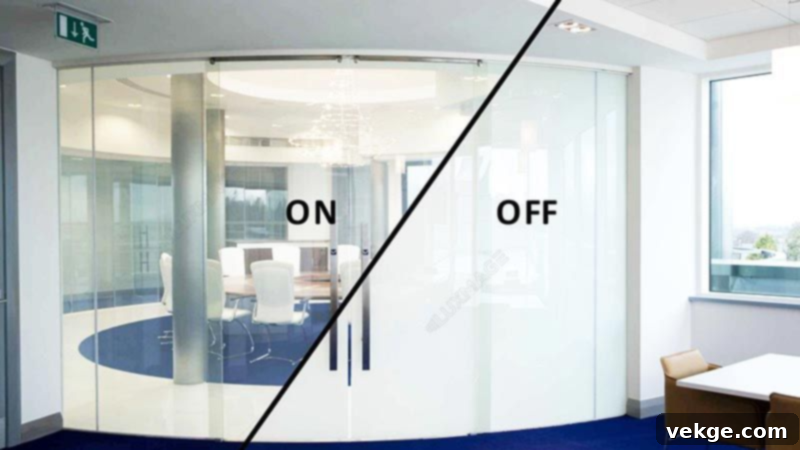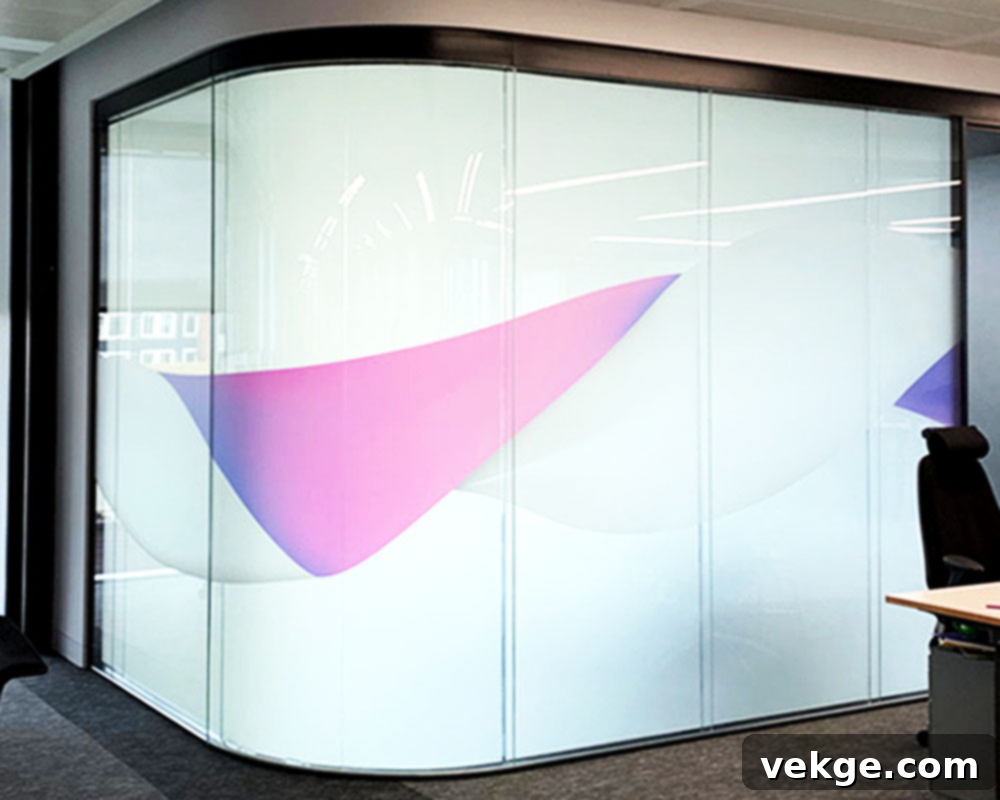Smart Film: Revolutionizing Modern Spaces with Dynamic Privacy, Smart Design, and Sustainable Living
The way we conceive, design, and interact with both private and public environments has undergone a remarkable transformation in recent years. Gone are the days of rigid, static spaces; instead, modern architecture and interior design prioritize flexibility, responsiveness, and user-centricity. Spaces are now expected to adapt seamlessly to our evolving needs, moods, and activities, fostering environments that are both productive and comfortable.
Much of this paradigm shift is powered by innovative smart technology that integrates effortlessly into our urban landscapes and personal dwellings. Contemporary design principles increasingly favor intelligent solutions that extend far beyond the basic functions of traditional building materials. Today, a house or building is demanded to be more than just a shelter – it’s an intelligent ecosystem. Among the vanguard of these transformative innovations, smart film stands out as a game-changer.
But what exactly is smart film? Often referred to as switchable glass film or privacy film, it’s an innovative material composed of Liquid Crystal Droplets (LCDs) suspended within a polymer. When an electric current is applied, these liquid crystals align, allowing light to pass through and making the glass transparent. When the power is switched off, the crystals scatter randomly, rendering the glass opaque and private. This dynamic control over transparency is what makes smart film such a revolutionary element in modern design.
Rethinking Privacy and Openness in Modern Spaces
The rise of open-plan living and working environments has fostered collaboration and a sense of spaciousness, yet it often comes at the cost of personal privacy. In many contemporary settings, traditional methods like curtains, blinds, or bulky partitions are deemed unsuitable or visually jarring. They can block natural light, accumulate dust, require frequent cleaning, and disrupt the clean lines of modern architecture. Moreover, these solutions offer a binary choice – open or closed – lacking the dynamic flexibility that modern life demands.
This is where smart film excels, offering an elegant and sophisticated alternative. It transforms ordinary glass into dynamic privacy screens with the flick of a switch, remote control, or even a voice command. Imagine a boardroom where glass walls instantly switch from transparent to opaque for confidential discussions, or a residential bathroom where a glass partition provides an abundance of natural light during the day, yet ensures complete privacy on demand. This technology preserves the aesthetic appeal of open spaces while granting instant, on-demand privacy without sacrificing natural light. It eliminates the visual clutter of traditional window treatments, maintaining an uncluttered, minimalist aesthetic.
Beyond offices and homes, smart film offers critical privacy solutions in sensitive environments like healthcare facilities (e.g., patient examination rooms, nurse stations) and financial institutions, providing discreet visual barriers when needed while maintaining an open, accessible feel at other times. Its non-porous surface also makes it a more hygienic option compared to fabric blinds, reducing allergen accumulation and simplifying maintenance.
Aesthetic and Functional Harmony for Contemporary Design
In the realm of interior design, the integration of technology no longer demands a sacrifice of style. In fact, cutting-edge solutions like smart film are meticulously engineered to enhance aesthetic appeal. Its sleek, unassuming profile perfectly complements the minimalist and modern decor prevalent in newly constructed buildings and renovated spaces. It seamlessly integrates with contemporary design sensibilities, offering a clean, sophisticated look that traditional window treatments simply cannot match.
Smart film elevates the overall appearance of various glass elements, including windows, glass doors, conference room partitions, shower enclosures, and even creative architectural features. Its ability to switch from clear to frosted instantly provides an element of surprise and sophistication, creating dynamic spaces that can change character at a moment’s notice. This aesthetic flexibility, combined with its profound practicality, is why leading architects, interior designers, and property developers increasingly choose smart film to infuse their projects with a distinctive style and individuality. It allows for the creation of visually striking environments that are also highly adaptable and functional, reflecting a forward-thinking approach to design.
Furthermore, smart film can serve as a high-definition projection screen when in its opaque state, offering a unique opportunity for dynamic displays, corporate branding, or interactive presentations in commercial settings. This dual functionality further underscores its value as a versatile design element, transforming a simple glass surface into a multi-purpose canvas for both privacy and communication.
Energy Efficiency and Sustainability for a Greener Future
With an escalating global focus on environmental conservation and sustainable living, the adoption of energy-saving technologies is no longer an option, but a necessity. Smart film makes a significant contribution to a building’s energy efficiency profile by actively managing solar heat gain and natural light. In its opaque state, the film effectively blocks a substantial amount of harmful UV and infrared (IR) radiation, which are primary contributors to heat buildup within interiors. By mitigating solar heat, smart film significantly reduces the load on a building’s heating, ventilation, and air conditioning (HVAC) systems, leading to tangible energy savings, particularly in warmer climates.
Beyond heat management, smart film optimizes natural light utilization. When clear, it maximizes the influx of daylight, reducing the reliance on artificial lighting during the day. This duality allows occupants to enjoy ample natural illumination without compromising on comfort or privacy. To further enhance its efficiency, smart glass can be integrated with advanced sensor technology and smart home automation systems. These systems can dynamically adjust the film’s opacity based on external weather conditions, ambient light levels, or even occupancy, ensuring optimal indoor climate and lighting conditions automatically. For instance, in direct sunlight, the film can automatically dim to reduce glare and heat, then clear up when conditions soften, or when more indoor light is desired. This intelligent automation translates into lower energy consumption, reduced carbon footprints, and a more environmentally responsible living or working space.
Properties incorporating smart film can also contribute towards achieving green building certifications such as LEED (Leadership in Energy and Environmental Design) or BREEAM (Building Research Establishment Environmental Assessment Method), enhancing their market value and demonstrating a commitment to sustainability.
Enhanced User Experience Through Seamless Control

The true power of smart film lies in its ability to significantly enhance the user experience, bringing an unparalleled level of convenience, control, and luxury to various environments. Whether in corporate offices, upscale hotels, or modern homes, smart film systems are designed for intuitive and effortless operation. Users can adjust the film’s transparency through a variety of methods: a simple remote control, a discreet wall switch, integration into a larger building automation system, or even via smartphone applications and voice commands through smart home assistants like Alexa or Google Home.
In the business world, this technology elevates the functionality of meeting rooms and presentation spaces. Glass partitions can instantly become private for confidential discussions or transform into high-tech projection screens for dynamic presentations, fostering a more engaging and efficient work environment. For hotels, smart film offers guests an elevated experience, providing instant privacy and a touch of modern luxury within their rooms and suites.
At home, smart film brings a new dimension of comfort and control to modern living. Homeowners can customize their environment with unprecedented ease. Imagine having glass walls in your bedroom that can switch from transparent to opaque with the push of a button, allowing you to enjoy an expansive view one moment and complete privacy the next. This level of personalized control over light, privacy, and ambiance integrates seamlessly with contemporary lifestyles, offering both convenience and a sophisticated aesthetic.
Beyond these applications, smart film can be integrated into dynamic art installations, retail store fronts for security and display purposes, and even into vehicles for enhanced privacy and glare reduction, demonstrating its vast potential for innovative user interactions.
A Smart Investment for the Future
While the initial cost of installing smart film may be higher than that of conventional window treatments, it represents a wise and forward-thinking investment with substantial long-term benefits and a compelling return on investment (ROI). Its multifaceted advantages far outweigh the upfront expenditure.
From a financial perspective, the energy savings garnered from reduced HVAC loads and optimized natural lighting can significantly lower utility bills over the lifespan of the property. The minimal maintenance required – no dusting, cleaning, or replacement of worn-out blinds or curtains – also translates into ongoing cost savings and reduced labor. Furthermore, smart film enhances a building’s appeal and market value, positioning it as a cutting-edge, technologically advanced property. This can be a significant advantage in competitive real estate markets, attracting discerning buyers or tenants who value innovation, efficiency, and modern amenities.
The durability of smart film also contributes to its investment value. Unlike fabric or plastic blinds that can fray, fade, or break, smart film is designed for longevity, offering a robust and long-lasting solution that requires little intervention once installed. As public awareness and understanding of smart building materials grow, the demand for and integration of technologies like smart film are projected to rise sharply, further solidifying its status as a prudent investment for any property owner or developer aiming for modern, sustainable, and adaptable spaces.
Looking Ahead: The Future of Adaptive Architecture
Adaptability is becoming an indispensable characteristic of modern architecture and design, and smart technologies are the driving force behind this evolution. Smart film is just one shining example of how innovation is transforming rigid, static spaces into dynamic environments that intuitively sense and react to changes in their surroundings and the needs of their occupants.
As these sophisticated solutions become more cost-effective and simpler to implement, their widespread adoption in both residential and commercial sectors is inevitable. This ongoing technological progression is not merely about convenience; it fundamentally reshapes our understanding of how we live, work, and interact with our built environment. It empowers us to create intelligent, responsive spaces that enhance our quality of life, promote well-being, and embody thoughtful, sustainable design principles.
The future promises even greater integration of smart film with Artificial Intelligence (AI) and the Internet of Things (IoT), enabling predictive capabilities based on weather patterns, occupancy habits, and personal preferences, leading to truly sentient buildings. This journey towards intelligent design is teaching us how to craft environments that are not just beautiful, but also intuitive, efficient, and profoundly human-centric.
If you’re looking to enhance your space with cutting-edge privacy and design technology, smart film offers a powerful, elegant, and sustainable solution for modern living and working environments. It’s an investment in the future of design, promising a blend of aesthetics, functionality, and intelligent control that redefines the capabilities of glass.
